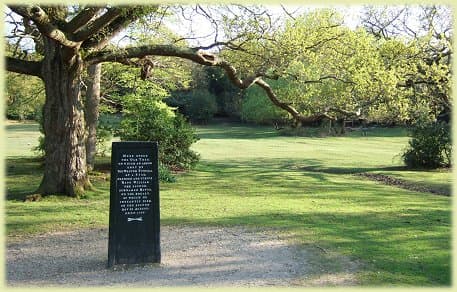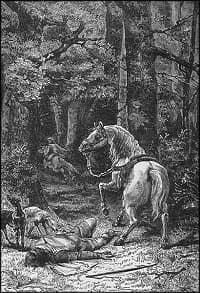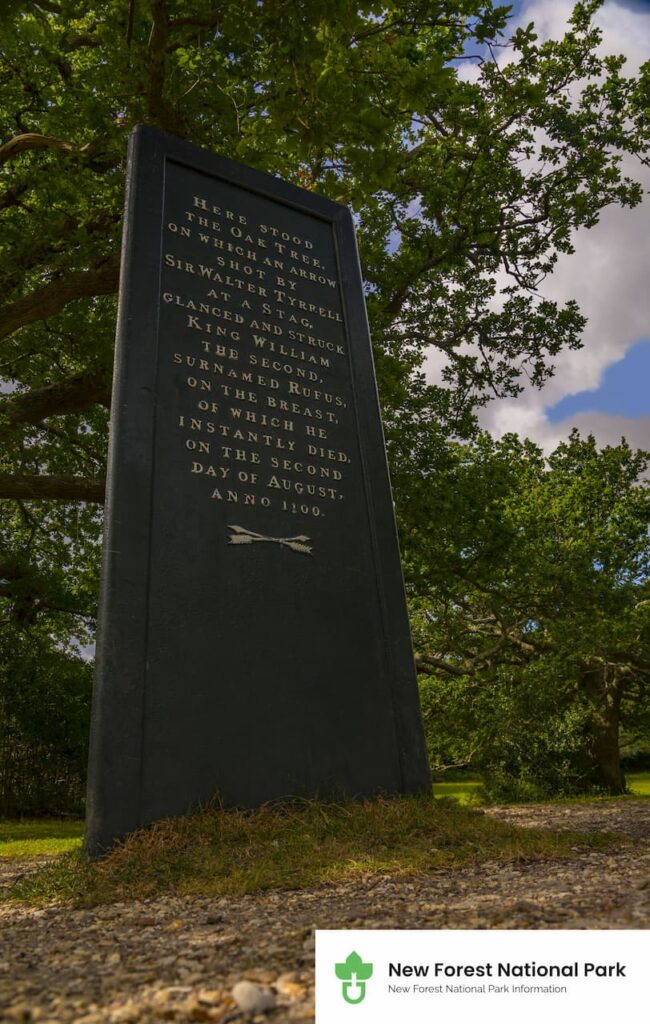The Rufus Stone
Overview
The Rufus Stone has to be one of the strongest reminders of the origins of the New Forest. The iron-clad stone marks the (alleged) spot where King William II was fatally wounded with an arrow, during a royal hunting outing in the Forest, in the year 1100 AD.
The king was nicknamed Rufus, apparently because of his ruddy complexion and red hair, and was of course the son of King William I who was responsible for designating the area as the royal hunting ground that we know today as the New Forest.
William Rufus was, by all accounts, an absolute barbarian and showed no mercy to the local inhabitants of the Forest, as well as being a fairly unpopular Monarch in general.
It was on August 2nd in the year 1100 when King William Rufus and his team of noblemen were out hunting deer and wild boar in the New Forest.
The story goes that an arrow was shot, supposedly at a stag, by the Frenchman Sir Walter Tyrrell who was the King’s best archer, but the arrow struck an oak tree and ricocheted off it straight into the chest of the king, puncturing his lung and killing him there and then (depicted in the 1895 lithograph shown right, © expired).
Sir Walter hot-footed it back to Normandy in fear of being charged with the King’s murder, the tale says that he stopped at a blacksmith on the way and had his horse re-shod with backwards facing horseshoes, so as to confuse the chasers!
As it happened, there were no chasers because no-one was particularly upset about the King’s death.
Indeed, there wasn’t even an effort to recover the king’s body by the Crown; a local charcoal burner named Purkis loaded the corpse onto his cart and carried it to Winchester Cathedral, where a somewhat low-key burial was performed.
Although time spent at the stone will be brief, there are several paths leading into the immediate Forest, and the popular Sir Walter Tyrrell pub is just a stonesthrow, or arrowshot, away – the guilty one’s name having been immortalised into one of the area’s most popular hostelries.
Directly opposite the pub is the grassy lawn of Canterton Glen, a nice spot to relax on sunny days or the start of a pleasant walk up through to Longbeech campsite on Stoney Cross.
Getting to the Rufus Stone
The Rufus Stone is accessible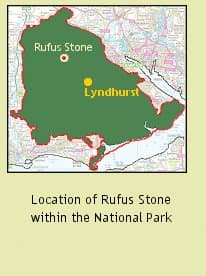
A31, the turning down to Rufus Stone is on the left, approximately halfway between the Stoney Cross and Cadnam exits.
Coming from the north, take the small road that rises uphill directly opposite the Bell Inn at Brook. After about a mile, the Stone is immediately after the Sir Walter Tyrrell pub, on the right.
A third option is to reach the stone (and pub!) by foot or on bike, coming down through Longbeech campsite on Stoney Cross. This is a very pleasant stroll but parts can get boggy after heavy rain, and there’s a stream to negotiate at the bottom!
GPS / SatNav information:
Lat/long: 50.911,-1.617. OS grid ref: SU270125

Why Time in Nature Complements Daily Astrological Guidance
Many of us start the morning with a quick look at our horoscope. A few lines can help name our mood, highlight a tension, or point out an opening in the day. What often gets
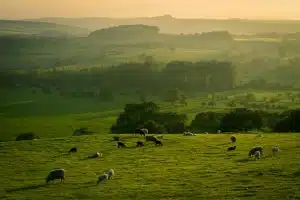
UK’s best natural spots
Wilderness escapes are not for everyone, that’s for sure. Some people simply prefer holidays where they can lounge all day and take it easy instead of being active, going hiking, swimming, or cycling. But there

Tech Hacks for Exploring the New Forest National Park
The New Forest National Park in the UK is one of Britain’s most enchanting natural destinations. Covering ancient woodlands, open heathlands, and winding walking trails, it offers visitors a chance to step back in time
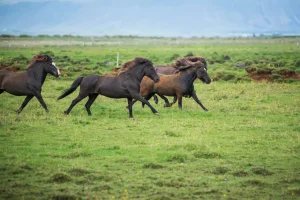
The Benefits of Outdoor Life for Horses
Life outdoors shapes stronger, healthier horses. Sunlight fuels the body with vitamin D, which helps bones grow dense and resilient. Space allows movement that stables cannot match. A horse stretching into stride, breathing clean air,

New Forest Getaway
The New Forest in southern England is unlike anywhere else, one moment you’re on a country lane, the next you’re face to face with a pony blocking traffic. Villages with thatched roofs appear out of

How Satellite Imagery is Transforming Wildlife Conservation
Today, a myriad of species and their habitats are struggling to survive and are on the verge of extinction due to permanent pressure on deforestation, climate change, and unlawful activities like illegal mining and logging.


